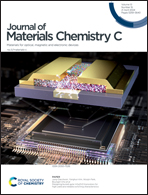Functionalized nickel oxide as a hole transport layer for organic solar cells with simultaneous enhancement of efficiency and stability†
Abstract
Organic solar cells (OSCs) have achieved rapid progress, with the power conversion efficiency (PCE) exceeding 19% based on conventional device configuration, in which PEDOT:PSS is the most commonly used hole transport layer (HTL). However, the use of PEDOT:PSS is problematic for the longevity of OSCs due to its hygroscopic and acidic nature. Herein, we have developed an alternative HTL by employing a self-assembled monolayer (SAM) of phosphate to functionalize solution-processed nickel oxide (NiOx) thin films, which are prevailing HTLs in state-of-the-art perovskite solar cells. As revealed by a combination of measurements, this SAM-modification can not only optimize band alignment by manipulating the work function of NiOx films, but also suppress charge recombination by passivating surface traps on NiOx films. With enhanced hole extraction efficiency and electron blocking ability, an impressive PCE of 16.7% is achieved in PM6:Y6-based OSCs with excellent reproducibility. Importantly, the optimized NiOx-based OSCs exhibit both superior stability and higher PCE than the PEDOT:PSS-based counterparts. This study provides a facile method for modifying NiOx to replace PEDOT:PSS as a reliable HTL for highly efficient and stable OSCs.



 Please wait while we load your content...
Please wait while we load your content...